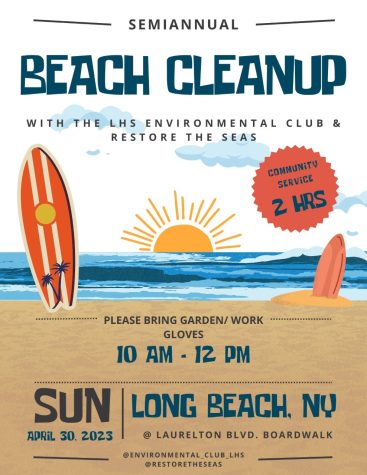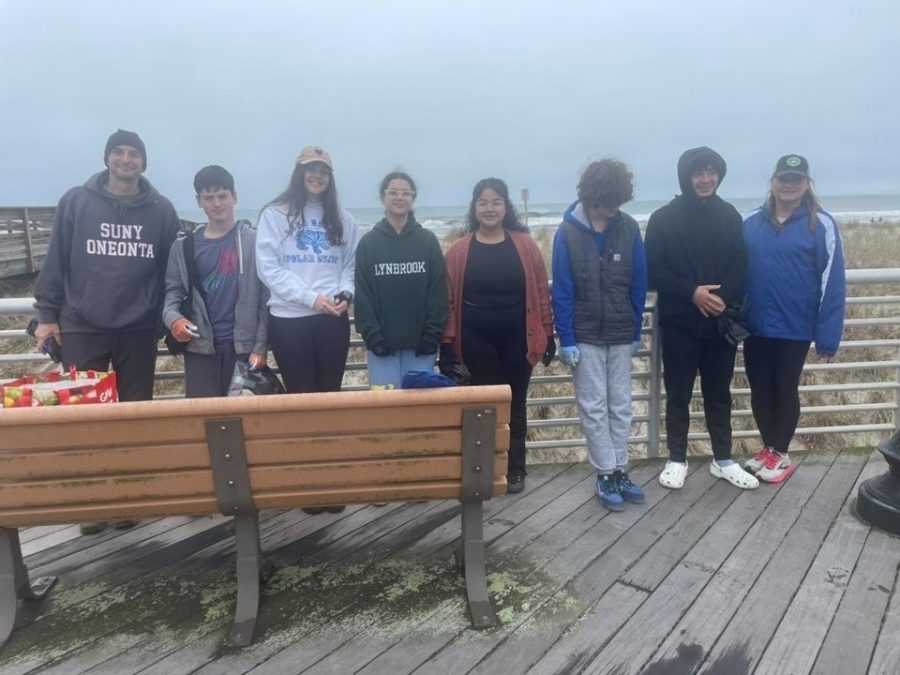Environmental Club Hosts Semi-Annual Beach Cleanup with Restore the Seas
The Environmental Club, along with beach cleanup organization Restore the Seas, ran its third semi-annual beach cleanup on April 30 at the Laurelton Boulevard Beach in Long Beach. Despite forecasted rain, over 20 volunteers from LHS and South Middle School showed up to help on a chilly Sunday morning.
The beach cleanup was cut from two hours to one due to torrential ran. The volunteers picked up 21.38 pounds of trash before the rain came. “I was very happy with the turnout of [the cleanup]. The forecast predicted rain all morning, so I was not expecting many participants. We had over an hour before the storm rolled in, so I would say it was a success,” said Robyn Raleigh, special education teacher and advisor of the club.

The Environmental Club advertised this cleanup through reminders on the morning announcements and flyers posted throughout the high school. In addition, they advertised the flyer on the club Instagram (@enviornmental_club_lhs) in collaboration with @restoretheseas. Matthew Schneck, an earth science teacher at South Middle and advisor of the middle school’s environmental club, did the same. “I believe beach clean ups are important because the health of the oceans reflects the overall health of the planet. Oceans feed us, regulate climate, and generate oxygen for us to breathe,” said Schneck. “Teaching students to be good stewards for the oceans at a young age is important because the habits and values we establish as adolescents often help to define our values and habits as adults,” added Schneck.
At both schools, students were encouraged to attend as they would earn two hours of community service that would fulfill their requirement for graduation. Jamile Batista, a freshman, was asked if she would attend more beach cleanups in the future; she responded, “Yes, I would. Not only was it helpful to the environment, but it was really fun.”
The Environmental Club and Restore the Seas have had great success running beach cleanups in the past. Their first beach cleanup was on May 15, 2022, at New York Avenue Beach in Long Beach. Over 40 volunteers came, picking up a total of 66.7 pounds of trash in just two hours. On October 23, 2022, they hosted their second beach cleanup at the same location. Seventeen volunteers came and picked up 40 pounds of trash in two hours in the rain. In addition to hosting their own beach cleanups, the Environmental Club participated in the beach cleanup on International Coastal Cleanup Day with the Fabien Cousteau Organization in 2021 and 2022. In 2021, over 16 students from the club participated in the cleanup.
During a club meeting before the most-recent event, members learned about the effects of ocean pollution when I, as the founder of Restore the Seas, presented to members. Club participants are often encouraged to present topics related to the environment at meetings to educate peers on subjects they feel passionate about. I originally founded Restore the Seas in 2020 as my Girl Scout Gold Award project. The organization started by running educational workshops about the importance of sharks and has progressed its focus towards beach cleanups and ocean pollution. Anyone who wants to run a beach cleanup with their school, team, or troop is encouraged to reach out via Instagram (@restoretheseas) or by email ([email protected]).
Beach cleanups are very important to the future of the ocean. “[Throughout the cleanup], we pick up as much litter and debris as we can find. The cleanups are important because trash can cause harm to marine life as well as the ocean itself. Each piece of litter that we pick up means one less piece of litter in our ocean,” said Raleigh.
Regardless of cleanup efforts, it is so important to end pollution at source. By reducing one’s use of single-use plastics, one can prevent trash from making its way to the beach in the first place. “The most common piece of trash I picked up were small pieces of styrofoam. Although styrofoam is banned in Nassau County, it continues to be a problem in the ocean,” said Schneck. It is estimated that eight million tons of plastic enter the ocean each year, adding to the estimated 5.25 trillion pieces of plastic already there. “The most common item [we found] was plastic from bottles and cans,” said Batista. Scientists believe that by 2050, there will be more plastic, by weight, in the ocean than fish. By combining the efforts of cleanup organizations and reducing plastic waste, it is possible to make a difference.
The Environment Club and Restore the Seas advise everyone to pay attention to their Instagrams for upcoming beach cleanups.

Hello! My name is Amelia Doyle. I am a member of the class of 2024. I play on the varsity volleyball team and the girls' varsity flag football team. I...























